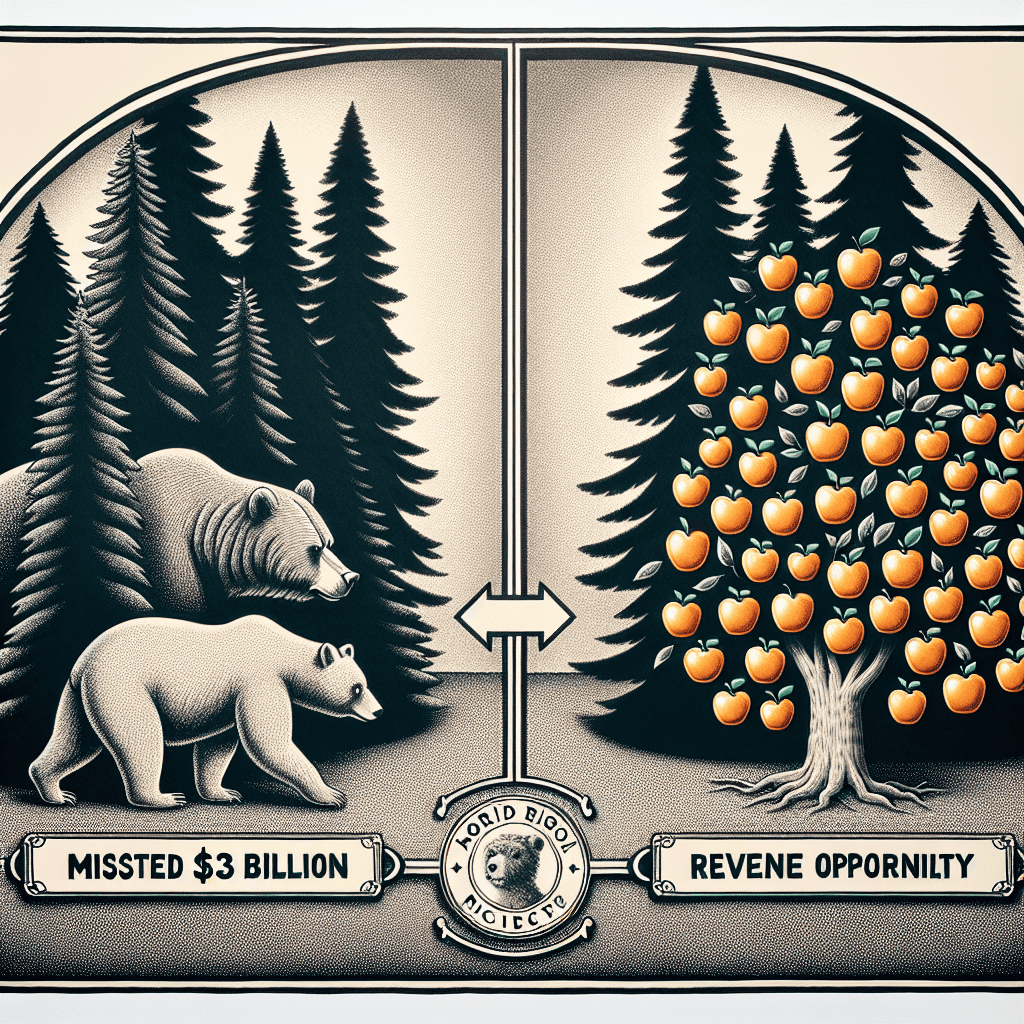“Trimming the Apple Tree: Berkshire Hathaway’s $23 Billion Missed Opportunity”
Introduction
Berkshire Hathaway, the multinational conglomerate led by renowned investor Warren Buffett, potentially missed out on a staggering $23 billion by reducing its holdings in Apple Inc. This decision, which involved trimming its stake in the tech giant, has sparked considerable discussion among investors and market analysts. Apple, a cornerstone of Berkshire’s investment portfolio, has consistently delivered robust returns, contributing significantly to the conglomerate’s financial success. The move to decrease its Apple shares, therefore, raises questions about the strategic considerations behind the decision and its implications for Berkshire’s future investment trajectory. As Apple continues to thrive in the technology sector, the financial impact of this reduction highlights the challenges and complexities inherent in managing a diversified investment portfolio in a rapidly evolving market landscape.
Financial Impact: Analyzing the $23 Billion Loss from Apple Holdings Reduction
Berkshire Hathaway, the multinational conglomerate led by the legendary investor Warren Buffett, has long been known for its strategic investment decisions. However, recent analyses suggest that the company may have potentially missed out on a staggering $23 billion by reducing its holdings in Apple Inc. This development has sparked discussions among financial analysts and investors, prompting a closer examination of the financial impact of this decision.
To understand the magnitude of this potential loss, it is essential to consider the context in which Berkshire Hathaway initially invested in Apple. The conglomerate began acquiring shares in the tech giant in 2016, a move that was initially met with skepticism given Buffett’s historical aversion to technology stocks. Nevertheless, the investment proved to be astute, as Apple’s stock price soared over the subsequent years, driven by its innovative product line and robust financial performance.
Despite the success of this investment, Berkshire Hathaway made the decision to reduce its Apple holdings in recent years. This move was part of a broader strategy to diversify its portfolio and manage risk, a prudent approach given the inherent volatility of the stock market. However, as Apple’s stock continued to climb, the decision to sell off a portion of its shares has been scrutinized, particularly in light of the potential $23 billion in missed gains.
The financial impact of this decision is multifaceted. On one hand, reducing exposure to a single stock can mitigate risk, especially in a portfolio as large and diverse as Berkshire Hathaway’s. By reallocating resources, the company can explore new investment opportunities and maintain a balanced approach to risk management. On the other hand, the opportunity cost of selling Apple shares at a time when the stock was poised for further growth cannot be overlooked. The $23 billion figure represents not only a missed financial gain but also a potential shift in the company’s overall valuation and market perception.
Moreover, this situation underscores the challenges inherent in investment decision-making, even for seasoned investors like Buffett. The stock market is inherently unpredictable, and decisions that seem prudent at one moment may appear less so in hindsight. This reality highlights the importance of strategic foresight and adaptability in navigating the complexities of financial markets.
In addition to the immediate financial implications, the reduction in Apple holdings may also have broader ramifications for Berkshire Hathaway’s investment strategy. As the company continues to evolve and adapt to changing market conditions, it may need to reassess its approach to technology stocks and other high-growth sectors. This could involve a reevaluation of risk tolerance, diversification strategies, and the criteria used to assess potential investments.
In conclusion, while the decision to reduce Apple holdings may have resulted in a potential $23 billion loss, it also serves as a valuable case study in the complexities of investment strategy. For Berkshire Hathaway, the challenge lies in balancing risk management with the pursuit of growth opportunities, a task that requires both strategic insight and a willingness to adapt to an ever-changing financial landscape. As the company moves forward, the lessons learned from this experience will undoubtedly inform its future investment decisions, shaping its approach to navigating the dynamic world of finance.
Investment Strategy: Lessons from Berkshire Hathaway’s Apple Decision
Berkshire Hathaway, the multinational conglomerate led by the legendary investor Warren Buffett, has long been a beacon of investment wisdom. Known for its strategic acquisitions and long-term investment philosophy, the company has consistently demonstrated an ability to generate substantial returns. However, even the most astute investors can face challenges in timing and decision-making, as evidenced by Berkshire Hathaway’s recent decision to reduce its holdings in Apple Inc., potentially missing out on $23 billion in gains.
Apple, a titan in the technology sector, has been a cornerstone of Berkshire Hathaway’s portfolio since the conglomerate began acquiring shares in 2016. The investment in Apple was initially met with skepticism, given Buffett’s historical aversion to technology stocks. Nevertheless, the decision proved to be astute, as Apple’s stock price soared, contributing significantly to Berkshire’s overall portfolio performance. Despite this success, Berkshire Hathaway opted to trim its Apple holdings, a move that has sparked considerable debate among investors and analysts alike.
The decision to reduce Apple holdings can be attributed to several factors. Primarily, it aligns with Berkshire’s investment strategy of maintaining a diversified portfolio. By selling a portion of its Apple shares, Berkshire could reallocate capital to other investment opportunities, thereby mitigating risk. Additionally, the sale may have been influenced by the desire to lock in profits, given the substantial appreciation in Apple’s stock price. However, this decision also underscores the inherent challenges in market timing, as predicting future stock performance is notoriously difficult.
In hindsight, the reduction in Apple holdings appears to have been premature. Apple’s continued innovation and strong financial performance have driven its stock price to new heights, resulting in a potential $23 billion in missed gains for Berkshire Hathaway. This outcome serves as a poignant reminder of the complexities involved in investment decision-making, even for seasoned investors like Buffett and his team. It highlights the delicate balance between risk management and capitalizing on growth opportunities, a challenge that all investors must navigate.
Moreover, this situation offers valuable lessons for investors seeking to refine their strategies. One key takeaway is the importance of maintaining a long-term perspective. While short-term market fluctuations can be unsettling, a steadfast commitment to a well-researched investment thesis often yields favorable results over time. Additionally, the case of Berkshire Hathaway and Apple underscores the significance of adaptability in investment strategy. As market conditions evolve, so too must the approaches employed by investors to ensure continued success.
Furthermore, this scenario emphasizes the role of diversification in risk management. While concentration in high-performing stocks can lead to substantial gains, it also exposes investors to heightened volatility. By diversifying their portfolios, investors can mitigate potential losses while still participating in market growth. This principle is a cornerstone of Berkshire Hathaway’s investment philosophy and remains relevant for investors of all sizes.
In conclusion, Berkshire Hathaway’s decision to reduce its Apple holdings, while seemingly prudent at the time, resulted in a significant opportunity cost. This experience serves as a testament to the complexities of investment strategy and the challenges inherent in market timing. For investors, the lessons gleaned from this situation are invaluable, reinforcing the importance of a long-term perspective, adaptability, and diversification. As the investment landscape continues to evolve, these principles will remain essential for achieving sustained success.
Market Reactions: How Investors Responded to Berkshire’s Apple Sale
In recent months, the financial world has been abuzz with discussions surrounding Berkshire Hathaway’s decision to reduce its holdings in Apple Inc., a move that has potentially cost the conglomerate a staggering $23 billion. This decision, made under the stewardship of Warren Buffett, has sparked a myriad of reactions from investors and market analysts alike, prompting a closer examination of the implications for both Berkshire Hathaway and the broader market.
To begin with, it is essential to understand the context in which this decision was made. Apple, a titan in the technology sector, has long been a cornerstone of Berkshire Hathaway’s investment portfolio. The conglomerate’s significant stake in Apple has been a major contributor to its financial success over the years, with the tech giant’s stock consistently delivering robust returns. However, in a surprising turn of events, Berkshire Hathaway opted to trim its Apple holdings, a move that has left many investors questioning the rationale behind such a decision.
In the wake of this announcement, market reactions have been mixed. On one hand, some investors have expressed concern over the potential missed opportunity, as Apple’s stock has continued to perform well, further appreciating in value. The decision to sell a portion of its Apple shares has, in hindsight, resulted in a substantial opportunity cost for Berkshire Hathaway, estimated at $23 billion. This figure represents the difference between the current value of the shares sold and the price at which they were offloaded, highlighting the financial impact of the decision.
On the other hand, there are those who view this move as a strategic realignment of Berkshire Hathaway’s investment portfolio. By reducing its exposure to Apple, the conglomerate may be seeking to diversify its holdings and mitigate risk, particularly in a market environment characterized by volatility and uncertainty. This perspective suggests that the decision to sell was not necessarily a reflection of a lack of confidence in Apple’s future prospects, but rather a calculated effort to balance the portfolio and explore new investment opportunities.
Furthermore, it is important to consider the broader implications of this decision on the market. Berkshire Hathaway’s actions often serve as a bellwether for other investors, given the conglomerate’s reputation and the influence of Warren Buffett. As such, the reduction in Apple holdings has prompted some investors to reevaluate their own positions in the tech sector, leading to a ripple effect across the market. This has resulted in increased scrutiny of technology stocks, with investors paying closer attention to valuation metrics and growth prospects.
In conclusion, the decision by Berkshire Hathaway to reduce its Apple holdings has elicited a range of responses from the investment community. While the potential $23 billion opportunity cost is significant, it is crucial to recognize the strategic considerations that may have influenced this move. As investors continue to navigate an ever-evolving market landscape, the actions of major players like Berkshire Hathaway will undoubtedly remain a focal point of analysis and discussion. Ultimately, this episode serves as a reminder of the complexities inherent in investment decision-making and the myriad factors that must be weighed in pursuit of long-term financial success.
Portfolio Management: Balancing Risk and Reward in Tech Investments

In the realm of portfolio management, the delicate balance between risk and reward is a constant challenge, particularly when it comes to investments in the ever-evolving technology sector. A recent example that underscores this complexity is Berkshire Hathaway’s decision to reduce its holdings in Apple, a move that, according to some analysts, potentially cost the conglomerate $23 billion. This situation highlights the intricate decision-making process involved in managing a diversified portfolio, especially when it includes high-stakes tech investments.
Berkshire Hathaway, under the leadership of Warren Buffett, has long been revered for its strategic investment decisions. The conglomerate’s substantial investment in Apple, initiated in 2016, was initially met with skepticism given Buffett’s historical aversion to tech stocks. However, this move proved to be astute, as Apple’s stock soared, contributing significantly to Berkshire’s portfolio value. Despite this success, the decision to trim its Apple holdings in recent years has sparked debate among investors and analysts alike.
The rationale behind reducing Apple holdings can be attributed to several factors. Primarily, it reflects a classic portfolio management strategy of rebalancing. As Apple’s stock price surged, its proportion within Berkshire’s portfolio grew disproportionately large, potentially increasing the risk associated with overexposure to a single asset. By selling a portion of its Apple shares, Berkshire aimed to mitigate this risk, ensuring a more balanced and diversified portfolio. This approach aligns with the fundamental principle of not putting all one’s eggs in one basket, a tenet that has guided Buffett’s investment philosophy for decades.
However, the decision to reduce Apple holdings also underscores the inherent challenges in timing the market. While rebalancing is a prudent strategy, it is not without its pitfalls. The tech sector, characterized by rapid innovation and volatility, presents unique challenges in predicting future performance. Apple’s continued success, driven by its robust product ecosystem and strong brand loyalty, has led to significant appreciation in its stock value. Consequently, the decision to sell shares, albeit for risk management purposes, may have resulted in missed opportunities for further gains.
Moreover, this scenario highlights the broader implications of managing tech investments within a diversified portfolio. The technology sector, with its potential for high returns, also carries substantial risks. Companies can experience rapid growth, but they are equally susceptible to market fluctuations and disruptive innovations. Therefore, portfolio managers must carefully assess the risk-reward profile of tech investments, balancing the potential for substantial gains against the possibility of significant losses.
In conclusion, Berkshire Hathaway’s decision to reduce its Apple holdings serves as a poignant example of the complexities involved in portfolio management, particularly within the tech sector. While the move was driven by a desire to maintain a balanced and diversified portfolio, it also illustrates the challenges of market timing and the potential for missed opportunities. As technology continues to play an increasingly prominent role in the global economy, investors must navigate these complexities with a keen understanding of both the risks and rewards inherent in tech investments. Ultimately, the art of portfolio management lies in striking the right balance, ensuring that risk is managed effectively while capitalizing on opportunities for growth.
Warren Buffett’s Perspective: Insights on the Apple Holdings Reduction
Warren Buffett, the legendary investor and chairman of Berkshire Hathaway, has long been known for his strategic acumen and ability to identify lucrative investment opportunities. His investment decisions are closely watched by market participants and often serve as a barometer for broader market trends. One of the most significant investments in Berkshire Hathaway’s portfolio has been its substantial stake in Apple Inc., a company that has consistently delivered impressive returns. However, recent reports suggest that Berkshire Hathaway may have potentially missed out on $23 billion by reducing its holdings in Apple, prompting a closer examination of Buffett’s perspective on this decision.
To understand the rationale behind the reduction in Apple holdings, it is essential to consider Buffett’s investment philosophy, which emphasizes long-term value and a deep understanding of the businesses in which he invests. Buffett has often stated that he prefers to invest in companies with strong economic moats, capable management, and a clear competitive advantage. Apple, with its robust ecosystem, loyal customer base, and innovative product line, fits this description perfectly. Therefore, the decision to reduce Berkshire’s stake in Apple may seem counterintuitive at first glance.
However, it is crucial to recognize that investment decisions at Berkshire Hathaway are not made in isolation. They are influenced by a myriad of factors, including portfolio diversification, risk management, and the need to allocate capital efficiently across various opportunities. By reducing its Apple holdings, Berkshire may have been seeking to rebalance its portfolio, ensuring that it is not overly reliant on a single company or sector. This approach aligns with Buffett’s prudent investment strategy, which aims to mitigate risk while maximizing returns over the long term.
Moreover, it is important to consider the broader market context in which this decision was made. The technology sector, while offering substantial growth potential, is also characterized by rapid changes and heightened volatility. By trimming its position in Apple, Berkshire may have been responding to these market dynamics, opting to lock in gains and reallocate capital to other promising opportunities. This move could be seen as a strategic adjustment rather than a lack of confidence in Apple’s future prospects.
Additionally, Buffett’s decision may have been influenced by the need to maintain liquidity and flexibility in Berkshire’s investment portfolio. As an astute investor, Buffett is always on the lookout for undervalued assets and potential acquisitions. By freeing up capital through the reduction of Apple holdings, Berkshire is better positioned to seize new opportunities as they arise, ensuring that it remains agile and responsive to changing market conditions.
While the potential $23 billion in missed gains is significant, it is essential to view this figure in the context of Berkshire Hathaway’s overall investment strategy and long-term objectives. Buffett’s track record of success is built on a foundation of disciplined decision-making and a commitment to value investing principles. The reduction in Apple holdings, therefore, should not be seen as a misstep but rather as a calculated move within a broader strategic framework.
In conclusion, Warren Buffett’s decision to reduce Berkshire Hathaway’s stake in Apple reflects a nuanced approach to investment management, balancing the need for diversification, risk mitigation, and capital allocation. While the potential missed gains are noteworthy, they must be weighed against the broader objectives of maintaining a resilient and adaptable investment portfolio. As always, Buffett’s actions underscore the importance of a long-term perspective and a commitment to sound investment principles.
Long-term Implications: The Future of Berkshire Hathaway’s Tech Investments
Berkshire Hathaway, the multinational conglomerate led by the legendary investor Warren Buffett, has long been known for its strategic investment decisions. However, recent analyses suggest that the company may have potentially missed out on approximately $23 billion by reducing its holdings in Apple Inc. This decision has sparked discussions about the long-term implications for Berkshire Hathaway’s future investments in the technology sector. As the company navigates the evolving landscape of tech investments, it is crucial to understand the factors that influenced this decision and what it might mean for its investment strategy moving forward.
To begin with, Apple has been a cornerstone of Berkshire Hathaway’s portfolio since the conglomerate first invested in the tech giant in 2016. Over the years, Apple has consistently delivered strong financial performance, driven by its innovative product line and robust ecosystem. The company’s stock has appreciated significantly, contributing to substantial gains for Berkshire Hathaway. However, in recent quarters, Berkshire Hathaway has opted to trim its Apple holdings, a move that has raised eyebrows among investors and analysts alike.
One possible reason for this decision could be Berkshire Hathaway’s traditional investment philosophy, which emphasizes value investing and diversification. By reducing its stake in Apple, the conglomerate may be seeking to rebalance its portfolio and mitigate risk. This approach aligns with Buffett’s long-standing belief in not putting all eggs in one basket, especially in a sector as volatile as technology. Nevertheless, this strategy comes with its own set of challenges, particularly when it involves a company as dominant and profitable as Apple.
Moreover, the decision to reduce Apple holdings may also reflect broader concerns about the tech sector’s future growth prospects. While technology companies have been at the forefront of market gains in recent years, there are growing concerns about regulatory pressures, market saturation, and geopolitical tensions that could impact their performance. By scaling back its investment in Apple, Berkshire Hathaway might be positioning itself to navigate these uncertainties more effectively.
Despite these considerations, the potential $23 billion opportunity cost associated with reducing Apple holdings cannot be overlooked. This figure underscores the significant impact that even small adjustments in investment strategy can have on a portfolio’s overall performance. It also highlights the inherent difficulty in timing the market, a challenge that even seasoned investors like Buffett face.
Looking ahead, the decision to reduce Apple holdings raises important questions about the future of Berkshire Hathaway’s tech investments. Will the conglomerate continue to shy away from large tech positions, or will it seek new opportunities within the sector? As technology continues to drive economic growth and innovation, maintaining a presence in this space could be crucial for Berkshire Hathaway’s long-term success.
In conclusion, while the decision to reduce Apple holdings may have resulted in a substantial missed opportunity, it also reflects Berkshire Hathaway’s cautious and diversified investment approach. As the company evaluates its future tech investments, it will need to balance the potential rewards of high-growth sectors with the risks they entail. Ultimately, the long-term implications of this decision will depend on how effectively Berkshire Hathaway can adapt its investment strategy to the ever-changing dynamics of the technology industry.
Comparative Analysis: Berkshire Hathaway vs. Other Major Apple Investors
In the realm of investment, few names carry as much weight as Berkshire Hathaway, the conglomerate led by the legendary Warren Buffett. Known for its strategic and often long-term investment approach, Berkshire Hathaway’s decisions are closely scrutinized by investors and analysts alike. Recently, a significant move by the company has sparked discussions and analyses: the reduction of its holdings in Apple Inc., a decision that, according to some estimates, may have cost the conglomerate approximately $23 billion in potential gains. This development invites a comparative analysis of Berkshire Hathaway’s strategy against other major investors in Apple, shedding light on the nuances of investment philosophies and market timing.
Berkshire Hathaway’s initial investment in Apple was a bold move that paid off handsomely, as the tech giant’s stock soared over the years. However, the decision to trim its stake in Apple has raised eyebrows, particularly in light of the stock’s continued upward trajectory. While Berkshire Hathaway remains one of Apple’s largest shareholders, the reduction in its holdings contrasts with the strategies of other major investors who have maintained or even increased their positions in the company. This divergence in strategy highlights the varying approaches to risk management and market speculation among institutional investors.
One of the key factors influencing Berkshire Hathaway’s decision could be its overarching investment philosophy, which emphasizes value investing and a focus on intrinsic value rather than short-term market fluctuations. Warren Buffett has often expressed skepticism about the tech sector’s volatility, and this cautious stance may have played a role in the decision to reduce exposure to Apple. In contrast, other major investors, such as mutual funds and hedge funds, may have a higher risk tolerance and a more aggressive approach to capitalizing on tech stocks’ growth potential. These investors might prioritize short-term gains and market momentum, leading them to maintain or increase their Apple holdings despite potential risks.
Moreover, the decision to reduce Apple holdings can also be viewed through the lens of portfolio diversification. Berkshire Hathaway’s vast portfolio spans various industries, and reducing its stake in Apple could be a strategic move to balance its investments and mitigate risk. This approach contrasts with investors who might concentrate their portfolios in high-performing tech stocks, banking on continued growth and innovation in the sector. The difference in strategies underscores the importance of aligning investment decisions with broader financial goals and risk tolerance levels.
Additionally, the timing of investment decisions plays a crucial role in determining potential gains or losses. While Berkshire Hathaway’s reduction in Apple holdings might appear costly in hindsight, it is essential to consider the context in which these decisions were made. Market conditions, economic forecasts, and company-specific developments all influence investment strategies. Other major investors who maintained their Apple positions may have had different assessments of these factors, leading to divergent outcomes.
In conclusion, the potential $23 billion that Berkshire Hathaway may have missed by reducing its Apple holdings serves as a compelling case study in investment strategy and decision-making. By comparing Berkshire Hathaway’s approach with that of other major Apple investors, we gain insights into the diverse philosophies and risk appetites that drive investment decisions. Ultimately, this analysis highlights the complexity of navigating the ever-evolving financial markets and the importance of aligning investment strategies with individual goals and risk profiles.
Q&A
1. **What is the main topic of the article?**
Berkshire Hathaway potentially missing out on $23 billion by reducing its Apple holdings.
2. **Who is the key figure associated with Berkshire Hathaway?**
Warren Buffett.
3. **What action did Berkshire Hathaway take regarding Apple?**
They reduced their holdings in Apple.
4. **How much did Berkshire Hathaway potentially miss out on by reducing Apple holdings?**
$23 billion.
5. **Why is Apple significant to Berkshire Hathaway’s portfolio?**
Apple is one of Berkshire Hathaway’s largest and most profitable investments.
6. **What is the potential impact of reducing Apple holdings on Berkshire Hathaway’s portfolio?**
It could have resulted in a significant loss of potential gains.
7. **What is a possible reason for Berkshire Hathaway’s decision to reduce Apple holdings?**
Portfolio diversification or profit-taking strategies.
Conclusion
Berkshire Hathaway’s decision to reduce its Apple holdings potentially resulted in a missed opportunity of approximately $23 billion, highlighting the challenges and risks inherent in portfolio management and timing the market. Apple’s continued strong performance and appreciation in stock value underscore the importance of strategic patience and the potential cost of reallocating investments away from high-performing assets. This situation serves as a reminder of the complexities involved in investment decisions and the impact they can have on overall portfolio returns.





